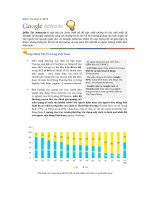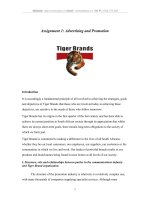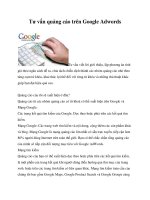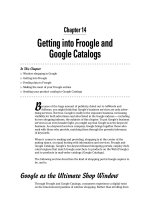Introducing Search Advertising and Google AdWords
Bạn đang xem bản rút gọn của tài liệu. Xem và tải ngay bản đầy đủ của tài liệu tại đây (787.35 KB, 14 trang )
Chapter 6
Introducing Search Advertising
and Google AdWords
In This Chapter
ᮣ
Discovering how search advertising differs from blanket advertising
ᮣ
Finding out the minimal requirements for using AdWords
ᮣ
Getting an overview of AdWords
ᮣ
Seeing the whole Google ad network
T
his first chapter on AdWords is an overview of both search advertising in
theory and AdWords in practice. I sketch the main points of Google’s ser-
vice here, and get into the details in later chapters.
Search advertising brings new marketing propositions to the table. This is
not to say that search advertising is brand new, but it is reaching a tipping
point (to borrow author Malcolm Gladwell’s phrase). Nobody knows what we
are tipping into. But there’s no question that search advertising, with its revo-
lutionary pay-for-performance model, precise targeting, and client control, is
rocking the advertising world.
This chapter argues the revolutionary benefits of search advertising, and
then proceeds to an overview of the preeminent search advertising venue:
the Google AdWords program. Be sure to reference the glossary at the back
of the book, which includes all important search advertising and AdWords
terms you’re likely to encounter.
Old Advertising in an Old Media
Let’s watch TV. I like Late Show with David Letterman, 24, and — even though
I’m so far beyond my teen years I can barely remember them — Smallville.
The two prime-time shows are presented in six acts broken up by commer-
cials. Letterman usually has six or seven segments separated by increasingly
11_571435 ch06.qxd 5/21/04 11:31 PM Page 103
longer breaks as the hour proceeds. Commercials take up nearly a third of
the shows’ time slots. Ads run the gamut: cars, beer, movies, insurance, and
medications for aging Boomers, computers, drugstores. They’re entertaining
or banal; long or short; punchy or pedestrian. And they’re almost all irrele-
vant to my desires and needs.
I’m not the only one complaining. Most TV ads are irrelevant to almost every-
one who sees them. Indeed, the irrelevancy is part of the plan in blanket
advertising. Blanket ads are shown indiscriminately to an entire audience,
with the idea that for every 20 (or 30, or 100) people who see the ad, 1 person
finds it relevant. Advertisers pay to reach that 1 person multiplied by huge
audience groups, and simply don’t care about the rest.
This sort of TV promotion was started in an earlier era, when both the
medium and society were more consolidated. In the 1950s and 1960s, televi-
sion for most people offered between three and six channels. Huge audiences
watched popular shows. (If you don’t remember watching The Ed Sullivan
Show every Sunday night, you’re younger than I am.) Furthermore, nothing
like today’s product diversity existed. So, in that simpler time, more people
gathered in bigger groups with more shared desires. Blanket advertising was
a reasonably cost-efficient way to get a message out to a great number of
people who would find it relevant.
Blanket ads still work, but finer targeting is now necessary. In the past, only
the most rudimentary sort of targeting was put into play — matching a prod-
uct to the type of audience likely to be watching a program. Now advertisers
match a product to age and lifestyle categories supplied by audience mea-
surement services. With the advent of TiVo and other personal video
recorders (PVRs), these services are becoming quite specific about the view-
ing and surfing habits of the TV audience. Nevertheless, blanket advertising
still works according to an old-media principle: Show the ad to everyone in
the target group, and hope it’s relevant to at least a few.
How often are TV ads relevant and interesting to you? Not often, I’m guessing,
even if you match the demographic targeted by a show’s sponsors. The irrel-
evancy of ads is why ad-skipping technology built into TiVo, ReplayTV, and
the other PVRs has become so popular. In fact, the TV industry is alarmed
about the ease with which the audience can time-shift its viewing and avoid
ads entirely. If the ads were precisely targeted to each of us, individually, we
probably wouldn’t want to skip them. At least, not as much.
Old Advertising in a New Medium
Relevance is the quality that makes an advertisement effective. This golden
rule is as true online as it is offline. We live in an ad-saturated age, but our
problem isn’t too many ads — it’s too many irrelevant ads.
104
Part II: Creating and Managing an AdWords Campaign
11_571435 ch06.qxd 5/21/04 11:31 PM Page 104
If ads could be targeted more specifically to what individuals want, the total
number of sponsored messages might not be reduced. But irrelevant adver-
tising systems that blanket us from billboards, airwaves, and all other media
would erode as advertisers flocked to promotional systems that didn’t waste
their money. This is where the Internet comes in.
But the Net hasn’t completely saved us from irrelevant ads. The online equiva-
lent of TV’s blanket advertising started with static banner ads and evolved to
video pop-ups. The latter format obscures the content of Web pages to play
commercials that, in the glitziest examples, look just like TV ads. These distrac-
tions are even pushier than a TV commercial because their style of interrup-
tion is more invasive. Whereas television schedules its commercials in planned
breaks, Web pop-ups fly right into your face while you’re trying to read a page.
They’re more intrusive than television, radio, or magazine advertising.
Pushy Internet ads are more galling than pushy TV ads because the Internet
is inherently a medium in which content is pulled, not pushed. Television is
more passive; the audience settles on its couches and lets content be pushed
at it. Changing to another station is traditionally the limit of a viewer’s con-
trol, or pull, over TV. (PVRs give the viewer more control, but that’s when ads
are skipped entirely.)
On the Internet, content appears on the screen when the viewer pulls it to
the screen, usually by clicking a link or bookmark. Some slightly pushy expe-
riences can occur online, as when somebody instant-messages you and the
IM window pops open on your screen. Even then, though, the pushy IM can’t
happen unless you give the messaging person your IM coordinates — a type
of pull. With e-mail, letters are pushed into your mailbox, but they don’t fully
appear on your screen until you click (pull) them.
Pushy advertising in a pull medium is bound to result in conflict. Sure
enough, banners, pop-ups, and spam are all extremely ineffective. They result
in such built-up consumer resentment and miniscule response rates that they
survive only because of economies of scale. Because they can be distributed
in massive numbers at low cost, even their dismal effectiveness pays out.
Generally, the least effective ad types (such as e-mail spam) are the cheapest,
making them the most pervasive and the most persistent. Spam is the
Internet’s most aggressive type of blanket advertising, with the least degree
of relevance. In principle, though, spam is no less pushy, broadly targeted,
irrelevant, and inappropriate to the medium than a video pop-up at a
respected Web site.
New Advertising in a New Medium
Now, finally, the Internet is poised to save us from irrelevant advertising.
Search advertising offers better response rates and better ways to track
105
Chapter 6: Introducing Search Advertising and Google AdWords
11_571435 ch06.qxd 5/21/04 11:31 PM Page 105
whether ads are reaching the right people. Search advertising is revolution-
ary in that it discards blanket advertising in favor of precise targets, con-
trolled costs, and meeting a pull medium on its own terms.
All Internet advertising, even the blanket type, contains an advantage over
advertising in most other media: It invites the viewer to take action immedi-
ately. Clicking an ad takes consumers to the next step in their relationship
with the advertiser. At that next step, some type of conversion is possible —
a sale, a registration, a bookmarked site, or some other behavior that “cap-
tures” the customer in a sense. Besides this dynamic quality of online ads,
search advertising makes four distinct and earth-shaking improvements on
blanket advertising:
ߜ Search advertising is positioned on results pages of search engines,
where the customer is looking for the advertiser. Well, perhaps the
customer is not literally looking for you, but he or she is looking for
something. The searcher is in a pulling mood — in the mood to consume
information, products, and services. If the advertiser provides relevancy
to that person’s search, the heavenly marketing match is made. And the
chance of a response is much greater than when a blanket ad wrenches
a viewer out of a passive state.
ߜ Search ads are aligned with keywords and appear on results pages
for those keywords. So, as long as the advertiser chooses keywords
appropriate to the message, and the searcher uses keywords appropri-
ate to the search goal, relevancy is guaranteed. Compared to the built-in
irrelevancy of blanket advertising, this degree of match-up between
advertiser and consumer is groundbreaking.
ߜ Search advertisers pay only for responses. The advertiser pays each
time a searcher clicks the ad. When that treasured click happens, the
advertiser receives a qualified lead — somebody who searched for some
combination of keywords and chose to click an advertisement that
promised relevancy as good (or better) than nonsponsored search
results. Contrast this method with the old-media system in which the
advertiser pays for sheer exposure. In the online universe, exposure
means paying for impressions — the number of times the ad is displayed,
even if nobody clicks it.
ߜ Search advertising offers detailed, multifaceted, hands-on control of
the advertising campaign. Google is particularly strong in this depart-
ment. Advertisers can micromanage their accounts, measuring perfor-
mance and enhancing their efficiency on a minute-by-minute basis. I
hasten to add that such obsessive management is not necessary in
search advertising. But the ability to control the campaign as it proceeds
represents one of the great advantages over broadcast and traditional
print advertising, in which you purchase a campaign and either it works
or it doesn’t. Tweaking, adjusting, and resculpting the campaign in mid-
stream to make it work is part of the search advertising system.
106
Part II: Creating and Managing an AdWords Campaign
11_571435 ch06.qxd 5/21/04 11:31 PM Page 106
Let me be clear. Google didn’t invent search advertising. Google didn’t even
invent pay-per-click (PPC) advertising, which has supplanted pay-per-impression
sponsored links on Google’s pages. But Google has refined the game consid-
erably, improving the basic parameters of search advertising.
Google is involved in PPC competition with other search engines, and to
some extent they leapfrog, one improvement after another. Generally, though,
Google has taken the lead in innovation. In particular, the following three fea-
tures are highly valued by Google advertisers:
ߜ Minimum payments. As I describe later, search advertisers bid on the
value of the keywords associated with their ads. Those bids determine
the ad’s position on the results page and the top amount the advertiser
pays when searchers click the ad. However, Google uses a complex for-
mula to determine the lowest amount the advertiser must pay, per click,
to maintain position on the page — and that is the amount Google
charges. All this is clarified later. The point here is that Google stream-
lines expenses by charging the least possible amount for advertisers to
compete effectively for position on the page.
ߜ Success breeds success. Unlike other PPC systems, Google factors an
ad’s success into the cost of keeping that ad in a high position on the
page. Position is partly determined by bid amount, but a very successful
ad with a low bid on a keyword can place higher than an unsuccessful ad
with a higher bid on that keyword. Success is measured by clickthrough
rate, or CTR. Here again, relevancy is the name of the game. Google cares
so much about providing its searchers with relevancy on the search
results page (in results listings and advertisements) that it rewards rele-
vant ads with discount pricing for high placement.
ߜ Conversion tracking. Getting a searcher to click your ad is the first step;
making a sale is the next step. The sale can be whatever the advertiser
wants from the customer; the desired action could be a simple site regis-
tration or signing up for a free newsletter. Whatever you want the cus-
tomer to do on your site after clicking through your ad, Google helps
track your success, or the conversion rate.
All this and more is bundled into the Google AdWords keyword advertising
program. If you’ve used Google, you’ve seen AdWords in action. Figure 6-1
shows a Google search results page with two AdWords ads, matching the key-
words cold climate gardening.
Broader searches (on the single keyword gardening, for example) return
pages with eight ads in the right column. In some cases, Google places ten
ads on the page: two above the search listings and eight in the right column.
Figure 6-2 shows a search on the keyword baskets, with AdWords ads above
and to the right of the index listings.
107
Chapter 6: Introducing Search Advertising and Google AdWords
11_571435 ch06.qxd 5/21/04 11:31 PM Page 107









